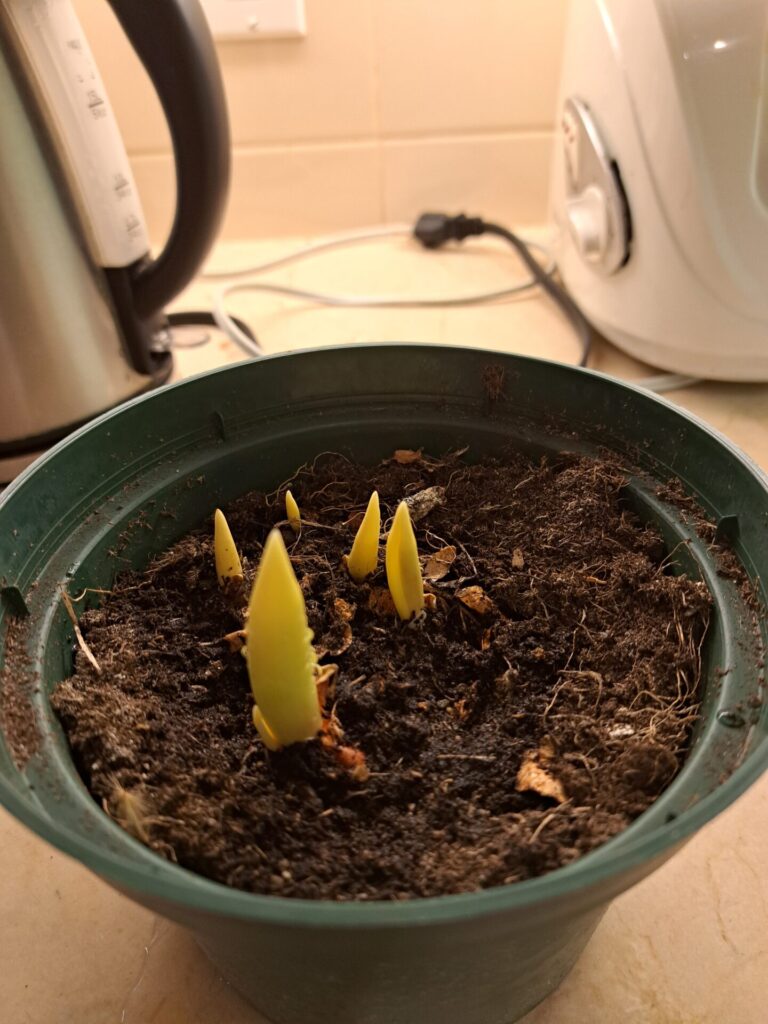
Hello, I live in Toronto. Many years ago – at least 10, probably more – I received a pot of tulips that were blooming. After they finished, I put the pot in our basement, intending to plant the bulbs in the fall, but I forgot. It has been in our unfinished basement since then, and no sign of life. I thought the bulbs were dead, but I never bothered to throw it out. I never watered it or did anything with it. What’s left of the soil is totally dry.
The basement room is unheated and cool, but the furnace is there, giving a certain amount of warmth. It’s humid in our basement, so maybe the soil absorbed some of the humidity.
Today I saw green shoots coming up! I can’t believe it after all these years. Should I plant the bulbs in the garden? We have a squirrel problem, but I can put hot pepper on them to try to keep the squirrels away.
Thanks in advance for your help.
Hello Gardener, and thank you for your inquiry to Toronto Master Gardeners. What a discovery to find these tulip bulbs have held their energy in a dormant state for such a long time!
From the photo, the pot appears very small, which would make it difficult to leave them there for their growth, bloom and die-back cycle. If the pot was larger, you could treat them like purchased spring blooming bulbs, let them grow through their cycle, bloom, die back, dry out and plant them in your garden in the fall.
Instead, gradually adjust them to the outdoor temperatures and sunshine (called hardening off). Start with just a few hours at a time per day, and start by placing them in a more protected spot from wind and direct sun as you help them adjust to the outdoors. Keep this small pot well-watered with good drainage so that they don’t dry out and can continue developing. Add more sun exposure each day. If you have an unheated garage for the evenings, that’s great, as we’re expecting some more typical very cool spring nights over the next several days. If you don’t have a garage, bring them inside for the colder nights as you work to harden them off.
After about a week to ten days of this you could plant them out. Dig a hole large enough to take all the soil from the pot and be careful to avoid disturbing their new roots too much.
To deter squirrels and provide an organic nitrogen boost to the tulips, you could apply a small amount (e.g. one teaspoon or less) of blood meal sprinkled on top of the disturbed soil around the bulbs. This fertilizer is associated with predators and works well to repel squirrels, rabbits and racoons. You may need to reapply a sprinkle of it a few times, especially after a rainfall, as the bulbs get established. However, note that blood meal can attract dogs or foxes.
The Canadian Wildlife Federation recommends using chicken wire around newly planted bulbs as a deterrent, as well as mesh bags (e.g. onion bags) with dog hair placed strategically around newly planted bulbs. You can get dog hair from a local groomer if necessary. Squirrels are attracted mostly to newly disturbed soil, and once plants are established they tend to lose interest. I have had great success using hardware cloth (wire mesh) over newly planted seed beds, to help keep them out until plants are established.
Don’t be disheartened if the bulbs don’t produce blooms this year, or only produce lacklustre blooms; they have been in the dark for a long time. With good feeding and development this spring and summer, they are more likely to produce good blooms next spring. Good luck with returned-to-life tulips!

